Erik Qualman's Blog, page 663
June 7, 2012
The 10 Biggest Research Scandals in Academic History
Sharing with you a recent published article by Larry Digman entitled, “The 10 Biggest Research Scandals in Academic History”. Enjoy!
Despite their ostensible intelligence, academics are not at all immune to engaging in risky behaviors that erupt in spectacular displays of controversy. Even if they ultimately prove innocent or unaccountable, their situations always pose inevitable questions about the ethics and legalities behind the research and publication process. The following incidents in particular managed to spark fireworks on an epic scale, inciting a flurry of insight into what needs to be done to better prevent any potentially damaging abuses.
Stephen Ambrose:This popular historian and professor enjoyed bestseller status and mainstream recognition for his inquiries into World War II, most notably The Wild Blue, and biographies of presidents Eisenhower and Nixon. By 2002, however, it came to light that Stephen Ambrose quite shamelessly plagiarized much of his research from lesser-known contemporary Thomas Childers, the author of Wings of Morning. Forbeslaunched a painstaking investigation into his oeuvre and unearthed entire passages lifted from other historians with no attribution whatsoever — in at least six books and his doctoral thesis, no less! Just as scandalously, the interviews compiled into his allegedly solicited biography of Eisenhower proved to be complete phonies as well.
James Crick, Francis Watson, and Rosalind Franklin:Both James Crick and Francis Watson scored themselves some sweet, sweet Nobel Prize lovin’ for discovering the double helix structure of DNA. Missing from the honors? Rosalind Franklin, whose research and X-Ray photographs proved integral to the groundbreaking find. The snub remains one of the most prominent controversies regarding the invisible role women played (and, occasionally, still play) in the sciences. While Watson and Crick cannot be said to have plagiarized since they built everything on top of her foundation, the scandal comes in their failure to properly acknowledge her contributions.
Jan Hendrik Schon:Bell Labs physicist Jan Hendrick Schon enjoyed a brief stint as the darling of all things nanotechnological — specifically, transistors — and the journals Science and Nature scrambled to publish his findings as quickly as he could write them. His fellow scientists, however, noted completely different results when replicating the experiments, with many of them openly questioning how exactly he came to his conclusions. Seeing as how this article isn’t about honest folks doing honest things (for the most part, anyways), what came next won’t shock anyone except for those with the absolute worst reading comprehension skills. When Schon’s employers and Stanford University set about confirming his findings, they found many of his notes missing or deleted, and his machinery too damaged to use. University of Konstanz stripped him of his Ph.D., the journals in question ripped out his offending articles, and the scientific community whipped itself up into a frothing mess arguing over peer reviews and accountability.
The Stanford Prison Experiment:The results may have proven both original and verifiable, but the infamous Stanford Prison experiment blew up over major ethical concerns. Psychology professor Philip Zimbardo set up volunteers in a jail simulation, assigning them roles as either prisoners or guards. Without interfering, he planned to study the dynamics of power abuse and submission/domination scenarios. And study he did, although the students assigned to the unregulated prison guard positions began displaying some distressingly aggressive behavior, going so far as to delight in beating their cowering classmates. Critics expressed understandable worry over what sort of psychological damage the environment and policy of nonintervention might instigate. However, in 1971, the American Psychological Association did grant Zimbardo permission to carry it out.
Ward Churchill:Mentioning former University of Colorado at Boulder ethnic studies professor Ward Churchill in certain settings raises tempers, whether directed at the school who fired him or the man himself. Controversies over whether he’s even of Native American descent aside, he wound up facing seven charges of academic misconduct, including allegations regarding plagiarized, falsified, and misappropriated data. Five of these proved egregious enough for the school to commence with the firing, which outraged both Churchill and his supporters. They believe his dismissal an attack on the First Amendment and his radical activist leanings, particularly his September 11 essay “On the Justice of Roosting Chickens,” which painted the terrorist attacks as inevitable and even deserved.
Duke University cancer research:Even after Jan Hendrik Schon inspired fiery discussions about peer editing academic research, Duke University’s scandalously falsified reports of a possible cancer cure managed to slip through and raise the serious issue all over again. Although he did not work alone, Dr. Anil Potti serves as the “face” of the potentially life-threatening controversy. His team published findings regarding predicting the spread of lung cancer cells in The New England Journal of Medicine, drawing excited gasps from healthcare professionals pondering the possibilities. But when MD Anderson Cancer Center researchers started testing and asking questions, the potentially earth-shattering article crumbled. Confirmation regarding their alleged manipulated results and stolen theories led to looks into Potti and academic partner Joseph Nevins’ credentials, and it came out that the former lied about a Rhodes Scholarship. Unsurprisingly, Potti resigned from his position at Duke in 2010.
Nancy Olivieri:Kids with serious blood disorders such as thalassemia traveled from all over the world to the Hospital for Sick Children in Toronto. There, hematologist Nancy Olivieri tested some new drugs underneath the sponsorship of pharmaceutical giant Apotex, hoping to find cures for their painful conditions. This meant stacks and stacks and stacks of papers governing confidentiality while she conducted her research, and scandal bubbled to the surface when she defied the paperwork and published findings revealing some nasty side effects in the patients who trusted her. Both the Hospital for Sick Children and University of Toronto joined Apotex in chastising Olivieri for breaking her contract, but she still expressed concern with The New England Journal of Medicine, ethics boards, and the Canadian government. Her boldness issued forth some challenges regarding what should really come first: contracts or the safety of patients?
Diederik Stapel:For well over a decade, Diederik Stapel of University of Groningen, University of Amsterdam, and University of Tilburg printed up more than a dozen psychological studies, which landed him success in both academic journals and mainstream news outlets. His 2011 suspension happened as a direct result of pretty much all of it being straight-up garbage. More than 30 publishing outfits found themselves duped by falsified research, plagiarism, and all other fun, grossly unethical good times. Although they maintain their anonymity for perfectly understandable reasons, it’s suspected that his notoriously abused graduate students – and maybe even a colleague or two – finally went and told the school what was up. Stapel currently contends with criminal charges filed by University of Tilburg for compromising the academic success of everyone who relied on his research.
Marc Hauser:Funny enough, this Harvard psychology professor specialized in cognition and morality. And then he wound up resigning in 2011 after a staggering eight counts of scientific misconduct. Both the National Science Foundation and the U.S. Office of Research Integrity went after him following accusations of falsified and incomplete data regarding his work with tamarins, much of which appeared in the journalCognition. Back in 1995, Hauser’s reputation already flickered in and out because of manipulated claims regarding monkey behavior as far back as 1995, but it wasn’t until 2010 when he really had to start answering for his ethical violations.
HeLa:When Johns Hopkins Hospital harvested Henrietta Lacks’ cervical cancer cells in 1951, no laws existed governing the ethics of using (or profiting off) them in medical research without the person’s consent — and especially not for an impoverished African-American woman. Journalist Rebecca Skloot’s inquiry into the history of how these perpetually-replicating biological marvels led to the creation of the polio vaccine and other earth-shattering scientific breakthroughs, The Immortal Life of Henrietta Lacks, renewed interest in the humanity behind the healthcare; in particular, questions regarding why so many made money from HeLa cells while her survivors remained in economic despair. It’s a complex, intricate situation to navigate, to be certain, and one whose scandal never fully coagulated until more than half a century later.
[image error]
June 6, 2012
10 New 2012 Social Media Stats = WOW!
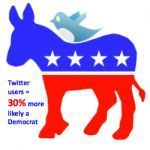
 Some shocking statistics were released by Edison Research. These stats come from the best & brightest in the business (Jason Falls, Jay Baer, Tom Webster, Mark Schaefer). Some of top “wow” statistics (based on Baer analysis):
Some shocking statistics were released by Edison Research. These stats come from the best & brightest in the business (Jason Falls, Jay Baer, Tom Webster, Mark Schaefer). Some of top “wow” statistics (based on Baer analysis):
10 Wow Social Media Statistics:
1. 47% = Facebook has greatest impact on purchase behavior
Last year, 68% of Americans using social networks said that none of those networks had an influence on their buying decisions. This year, only 36% said that there was no influence. Now, 47% say Facebook has the greatest impact on purchase behavior (up from 24% in 2011). Incidentally, Twitter dramatically underperforms in this category at 5%. If you want to drive purchase behavior -> Facebook is the place to start. Now, can Facebook figure out how to monetize this?
2. Twitter users are 33% more likely to be Democrats
40% of Twitter users are Democrats vs. 30% of the U.S. population overall.
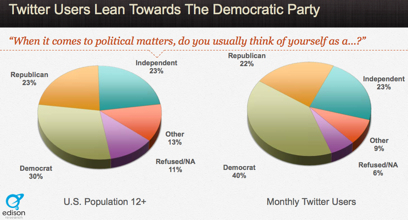
3. Users that follow brands on social media increases 106%
From 2010 to 2012 the percentage of Americans following any brand on a social network has increased from 16% to 33%. This is a sharp increase, but also means that 2/3 of Americans using social networks have never followed a brand. So, there is still a tremendous amount of room for growth here.
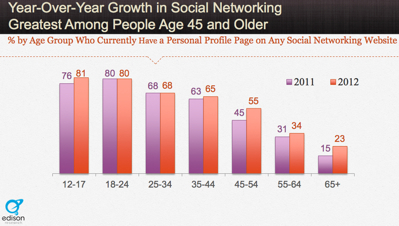
Click chart to download entire report
4. Fastest growing segment in social media = 45-54 year-olds
It’s not just for kids any more. The biggest growth of any age cohort from 2011 to 2012 was 45-54 year-olds, in fact 55% of Americans 45-54 now have a profile on a social networking site. The only group that is below average, in terms of expected participation, on social networks, are 55+ Americans, and even 3 out of 10 of them are in the social networking game.
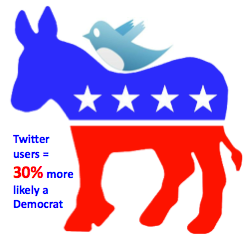 5. People don’t “Check-in” | Sorry Foursquare
5. People don’t “Check-in” | Sorry Foursquare 74% of Americans are unfamiliar with the concept of checking in to a location via mobile device, and only 3% have ever checked in. This is a drop-off from 2011 where 4% of those surveyed had checked. Foursquare would be best served trying to be the solution that replaces all of our loyalty cards (CVS, Eddie Bauer, Kroger) at the point of purchase rather than continue with a lackluster business model.
6. 54% of Facebookers access via mobile
54% of Facebook members have used the social network via a phone, and 33% use a phone as their primary way to access Facebook. This despite the fact that the Facebook mobile experience and mobile apps are mediocre, at best. Part of Facebook IPO woes have been the result of them, not properly monetizing, the mobile market.
7. Facebook is the most addicting social network
23% of Facebook’s users check their account 5 or more times DAILY. The mean number of daily look-ins by Facebook users is 4.
8. Twitter is grabbing more new customers
53% of Twitter users have been a member for less than a year, compared to just 19% for Facebook. This fresher base could prove an advantage to Twitter moving forward.
9. 76% of Twitter users now post status updates
This is one of the biggest behavioral changes of the past two years. In 2010, the Social Habit research found that just 47% of Twitter users actually sent tweets, with more than half the user base in listen-only mode. The overwhelming majority of new Twitter users are active tweeters, driving the overall average to 76%.
10. 22% use social networking sites several times per day
It really is a “Social Habit.” In the past year, 12 million more Americans are using social networking many times daily.
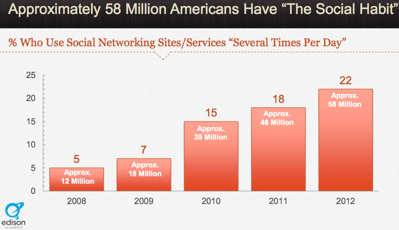
Click the chart to download entire report
Which stat was your favorite? As an independent voter I found #2 fascinating – does this give Obama an edge in the election? What do you think?
You can access the entire research deck at The Social Habit microsite. More great stuff from Jay Baer here.
[image error]
June 5, 2012
Getting Your Daily Dose of (Social) Inspiration with Beliefnet

Even the most motivated among us can use some extra inspiration. This is where Beliefnet comes in. One of our most inspiring customers, Beliefnet is the largest multi-faith inspiration and spirituality website, offering community, services and information on a wide variety of topics including inspiration, health, entertainment, love and family, and holistic living. We recently sat down with Jana Gordon, digital media coordinator for Beliefnet, to chat about their great social community success and Jana’s tips for lasting community-building.
For starters, Beliefnet works with over 100 established bloggers who bring the company’s mission to life by helping people “find, and walk, a spiritual path that will bring comfort, hope, clarity, strength, and happiness.” Besides being one the most popular websites with more than 15,000 resources linking to Beliefnet for inspiration, the company has a vibrant Facebook following, counting over 81,000 fans and growing, all without any advertising help. Beliefnet’s Twitter following is as impressive – counting over 22,000 combined followers across three Twitter accounts, @bnetcommunity, @BNetInspiration, and @beliefnet. As one might imagine, inspiration comes in different forms, so for your daily dose of inspiration, you can also visit their Pinterest page. Ranging from the truly spiritual to downright funny…

…Beliefnet brings an upbeat perspective and makes a positive difference in the lives of millions of people
Yes, it is actually someone’s job to check to see whether the new and improved under-arm deodorant actually works. As our friend at Beliefnet points out, the next time your boss thinks you should turn in your reports on time, just remember — it could be worse. You could be an armpit auditor!
What is Beliefnet’s secret to social marketing and community success? It is all about understanding what moves your community, coupled with relevant engaging content, says Jana. But please don’t think Beliefnet’s success it is just about talented writers and employees, of whom Beliefnet is very proud. Great content is a main ingredient in moving people to embrace a brand, but marketers also need to know what content moves their customers the most. For those deep customer insights, Jana turns to web and social analytics – she monitors popularity of content within the company’s newsletter, responses in social media, and visits to their website. Then, she hones her effort on creating the content that keeps people coming back. To her, engaged community members is what their brand is all about.
Then there’s the matter of Beliefnet’s member servicing. Their social following and engagement have grown to its current level because of the company’s commitment to member advocacy. Jana doesn’t just track visits and time on site – she keeps an eye on how their content is shared through retweets, ‘Likes’, and comments, especially by those members with the most influential voices. In turn for their support, those influential members are rewarded publicly via the company’s Fan of the Week program on Facebook.
One of the most successful content types that Beliefnet’s utilizes are their daily inspirational quotes. The “Love God. Love People. Love Yourself.” photo posted on Facebook generated over one thousand Likes and shares.

And if you are not sure what faith you are, don’t worry - Belief-O-MaticTM knows. Answer 20 questions about your concept of God, the afterlife, and human nature, and Belief-O-Matic will tell you what religion (if any) you practice…or ought to consider practicing. Want to know mine? It will be revealed on Twitter in the coming days…
Where do you get your daily dose of inspiration? How do you inspire your social following? Share your inspiration quotes, tips and advice with us on Twitter or Pinterest.
May you all live healthy and prosperous lives!
@BostonMike
[image error]
June 4, 2012
Facebook block on Pinterest

I saw this interesting photo of a puppy in a Baby Bjorn (see below) on Englishtown’s Facebook Fan Page. Would you ever carry your puppy like this?
I went to pin this to my Pinterest account and received a pop-up message (see below) indicated I couldn’t pin directly from Facebook. So this begs, the question, with some reports indicating that Pinterest is helping to drive more traffic to sites than Twitter…Is Facebook missing out on additional traffic? What are your thoughts?
[image error]
Is Facebook's block on direct pins for Pinterest hurting Facebook traffic?
[image error]
May 31, 2012
Frustrations with Web Security at Work | @#$%!

Ever felt like the people in this focus group when it comes to what is blocked at your office?
Hope you enjoyed this humorous video and the below statistics from CBS and an SHRM survey of 532 human resource personnel :
43% of Companies Block Social Media Sites:
The sites most likely to be blocked to employee use were:
1) Facebook (39%)
2) Myspace (38%)
3) Twitter (33%)
4) YouTube (32%)
5) iTunes (26%)
Only 16% of companies said they blocked LinkedIn. Another reason to buy LinkedIn stock.
Related Posts: Social Media Tools
[image error]
Return on Influence: Harnessing The Power of Social Influencers with Mark Schaefer

With social media influencing 90 percentof all purchases, it’s a potential gold-mine for marketers. But how can marketers harness the social influence of others to increase brand advocacy, generate cost effective impressions and increase audience reach? One effective tactic is to create campaigns that will appeal to their target audiences led by those they consider influential.
[image error]
Ford gave 100 social media influencers a European model of the car and asked the new owners to record taking the car on “missions.”
Consumers take cues from our environment into account when making decisions. In social media, we look to cues like number of followers and Klout scores for badges of social proof. This influences who we follow because ultimately, people will do what they see others doing. The more followers someone has, the more likely one is to believe that s/he is worth following. But what creates the social influence in the first place that drives social proof? It’s in the content. The content that people share builds their social influence, and then their social proof.
To learn more about strategies to identify and empower influencers to spread brand content, we connected with Mark Schaefer, globally-recognized blogger, educator, and business consultant with 30 years of experience. During his webinar with us, Mark shared insights from his new book Return on Influence: Understanding the New World of Social Media Influence Marketing (download a free chapter) on how to empower users to spread content and grow influence.
Content is power.
Mark says that “content that moves through a network is a legitimate source of influence and power.” With over 30 billion pieces of content being shared on Facebook alone each month, it’s not hard to believe. Mark notes that it’s what we share that attracts followers. The quality of what we talk about grows our influence. In fact, most influencer tools – like PeerIndex and Klout -examine what users talk about, who responds to it and whether it is shared when determining a user’s influence.
Who are social influencers?
As Mark puts it, “influence is now democratized.” We are no longer looking to celebrities to influence sales decisions, but often to ‘regular’ people. Mark cites a few excellent examples as proof that moving content can create influence and power:
Meet Calvin Lee, @mayhemstudios. Calvin is an exemplary social influencer – a talented (and shy!) graphic designer from Los Angeles who tweets 200 times a day, sharing great content with his 76,444 followers on Twitter. He’s grown this following not because he’s famous, but because he thoughtfully shares content that helps his audience. With a Klout score of 80, Calvin has become so influential that brands like American Express, Walt Disney and Subway have approached him in hopes that he will mention them. In fact, Audi asked Calvin to take their new A8 on a week-long test drive, where Calvin tweeted about the car’s performance and his appreciation to Audi for the experience. The House of Blues invited Calvin to a celebrity event in Las Vegas, and VH1 invited him plus seven of his friends to the VH1 awards to “hobnob with the stars.” Calvin can give brands the boost in social awareness and interest they are seeking.
For marketers, we need to consider what our audience is looking for and how an influencer campaign can impact this. One effective influencer tactic to consider is giving them exclusive content and offers. The perks make your influencer feel special and, although it may not be specifically requested, they blog, tweet and share their genuine experiences. Ultimately, this influences others and drives in-store actions and purchases. A few of my favorite examples come from companies like Ford, Chevy and Virgin Airlines, who are exploring interesting campaigns leveraging the power of social influence. Here are some examples of exclusive campaigns for qualifying social media influencers:
In case you are not already familiar with the success of Ford’s Fiesta campaign, Ford gave 100 social media influencers a European model of the car and asked the new owners to record taking the car on “missions.” The 6.5 million views from these video missions resulted in the sale of some 10,000 cars in the first six days. Now, Ford is teaming up with the PeerPerks program from PeerIndex to take on its largest social influencer campaign ever. The company will offer 1,000 qualified individuals a special gift – Ford’s new ‘baby carrier,’ the Ford B-Max, launching summer 2012.
Chevy Volt has teamed up with Klout for several social influencer campaigns. Previously, Chevrolet loaned Volts to 20 consumers in the Chicago-area, and later loaned the Sonic to 130 influencers. Recently, Chevrolet launched a new campaign giving a select number of Klout influencers (with scores over 50) a chance to borrow 2012 Volts for three-day joy rides in hopes of generating sales. The April 2012 campaign launched in Denver, Los Angeles, San Francisco, Seattle and is slated to head to Portland.
Klout also collaborated with Virgin Airlines to offer top Twitter influencers one free, round-trip flight from Los Angeles or San Francisco to Toronto. Mark Schaefer actually blogged about this event on his site, reporting that Virgin Airlines generated 4,600 tweets, 7.4 million impressions, and received coverage by top publications like CNN Money and L.A. Times.
Although referencing influencer tools like Klout and PeerIndex are a good place to start researching, Mark encourages marketers to take a broader approach to influencer identification. Remember, the content that people share, and the subsequent reaction to it by peers, is what drives a Klout score to begin with. A high Klout score doesn’t make you influential, the content you post does.
To catch more insights from Mark you can watch the full webinar, pick up his other book Return on Influence: Understanding the New World of Social Media Influence Marketing or follow his {grow} blog. Additionally, you can download a free chapter of his book.
Tweet us your Social Influencer Tips! How do you engage with your social influencers? Do you know of any favorite influencer campaigns? Tweet us your tips to #AwarenessTips.
Mike Lewis
[image error]
May 29, 2012
Yelp! I’ve Fallen! And, I Can’t Get Up!

“I’ve fallen, and I can’t get up.”
~Famous–and incessantly mocked–line from Lifeline Medical Alert TV spot
IF YOU’RE A BUSINESS OWNER, the pain of getting “Yelped” falls somewhere between a moderate migraine and a worm burrowing in your brain.
There you are: cheerfully flitting about, running a beautiful business–and BLAMO! A rageaholic on a bad day (or rather, a bad life) spends an inordinate amount of time churning out pure vitriol about your brand. Vitriol that spews every minute of every day rearing its sinister head–sending potential customers into the warm embrace of…your competition.
Frightful, I know. But, it’s a scenario that plays out thousands of times every day.
In this “word-of-mouth” economy, people trust one another more than company messaging. In fact, a recent eMarketer study found that people trust peer reviews roughly 14 to 1 over traditional marketing.
So there we have it. You may work for a billion-dollar brand with a veritable army of PR and communications people, but one articulate, scathing review on a popular review site can burn through your brand equity–and there’s almost nothing you can do about it.
Or is there?
My agency has worked with dozens of clients, monitoring their brands and managing their online reputations. We’ve learned jaw-dropping lessons about the art and science of reputation management–and I’d like to share some of what we’ve learned with you.
First, please understand–and I said it above–you are not in control. And, that’s okay. Trying to muscle your way through this process will only draw the ire of the Yelper–and the community. It’s like leading a horse to water and forcing him to drink. Not a good idea.
We’ve seen it time and again with vaunted brands from Bank of America to United to Verizon. They have plenty of resources to put out fires, but because they responded so poorly, even they could not contain the tsunami-like revolts against them.
Brands have never been at greater risk than they are at this moment. That risk grows not by the day, but by the minute. The power of the people is becoming greater than the people in power.
You cannot control the message. But, you can shape it.
That is why reputation management has become such an integral component of social media. It is important, yet simple to develop. It requires three things: smart planning, proactive listening–and the right response.
Before you respond to an online review, take a breath. No seriously, take a nice big, cleansing breath. If you must, write your angry response. Then, toss it. It will do more harm than good. And, really: When you get down to it, this one review will not matter one bit to the 70 year-old you. Let’s keep things in perspective here.
3 THINGS TO LOOK FOR
1. What is your aggregate rating? If your business is ranked above four stars on Yelp, Amazon or any other review site, studies show that the impact of one negative post is less significant. People look at your aggregate rating and number of reviews (for statistical significance). If you’re good on both (e.g. 4 stars, 62 ratings), you’re good. All you need to do is reach out to the person and post a diplomatic, decisive and public statement (See below).
2. How bad is it? Not bad as in bad, bad as in good. In other words, is it a well-composed, articulate, fact-based and non-emotional critique from someone with credibility on the review site, or worse: Web-wide? (If so, it’s time to start panicking slightly. See below.)
3. Is the person unstable? If so, that actually works in your favor. Remember most people are reasonable, forgiving human beings. If they see someone going off half-cocked IN ALL CAPS, as in: “MY FOOD WAS 1 MINITE (sic) LATE! AND THESE PEOPLE COULDN’T CARE LESS ABOUT MY DINNER OR MY PAIN OR MY DIVORCE! I HATE THAT WOMAN!!!!!!!!! (9 exclamation points), the people reading know the person is angry with the world and not so much their pasta primavera, and they’ll put that review in perspective.
Before I talk about how to handle a negative online review, let’s start with how to prevent it. (Sounds morbid, but this is analogous to cancer-prevention. You don’t want cells metastasizing in the first place, so preventative medicine goes a long way.) Remember: “an ounce of prevention is worth a pound of cure.”
3 WAYS TO PREVENT IT
1. Fix Things Fast. Make it clear to everyone at your company that they treat every client, caller, and anyone with whom they have contact as if they are family members and A-list journalists. Customer service 3.0 if you will. People are empowered now, and they are intoxicated with that power–and you never know who you’re talking to. You needn’t let people walk all over you, but you need to provide A+ customer service.
2. Listen All the Time: Put your ear to the ground and listen to what people are saying. Seven days a week. Not doing this because you are “afraid of what you’ll find” could be the death knell of your business. What are people saying? Is it accurate? If someone flames your company, don’t default to: “How can we get rid of this post? Ask: “Are they right? What can we do to fix it–and build a better business?” Bad reviews provide good insights. Important note: I advise against relying too heavily on technologies for “sentiment analysis.” I speak from personal experience: At the time of this writing, even the best technologies miss critical posts, misjudge “sentiment” (e.g. human sarcasm)–and lack the human element necessary for effective brand management. Your company is too important to leave to green technologies. Put trained, human eyes on this stuff. After all, your reputation is a precious asset.
3. Do the Right Thing. When you engage in social media, be honest, care about your customers–and do the right thing. If you make a mistake, acknowledge it. Offer to fix it—and then, do it. Bring “old school” to “new media.”
3 WAYS TO HANDLE IT
1. Contact the Person Privately. Bring nothing but humility, accommodation and diplomacy to your dialog with the critic. Letting even the slightest bit of frustration or anger into the discussion will backfire (I promise). Do not focus on the review. Focus on making things right. Gone are the days when you can issue a press release to respond to crises—and be done with it. “Corporate statements” are now not only largely ineffective, they can be counterproductive. If I were advising Bank of America amidst their debit-card-disaster, I would have said: “Look, you were being greedy. Five dollars a month to use a debit card? Consumers are already spitting-angry with banks. So, do something unprecedented. Set a new standard: admit it. Apologize (and mean it). And, commit to treating customers like family. If you do that, you will win the hearts of millions. If you keep doing business-as-usual, you will continue to get pummeled–with increasingly devastating blows.” (Think they would have taken that advice? Not likely.) You can turn your most vitriolic critic into your most vocal evangelist if you have humility and listen.
2. Do Not Get Drawn Into a Fight. As Oliver Blanchard says in his must-read Social Media ROI (Que, 2011): “Never get defensive, never take attacks personally, and never allow yourself to be drawn into an argument. Present the facts calmly and professionally, monitor the impact of your activities on topics relating to your brand and overall sentiment, and either press on with your response or move on.”
3. Make a Public Statement. This is critical. It needs to be concise, civil, sophisticated and decisive. With your public statement, you’re not trying to win over the critic (although that would be nice). You are speaking to the thousands of people who are observing the conversation without contributing to it. You want to win over all of the people who are “on the fence” about your brand. Your public statement must come from a real person (e.g. Janice, Customer Service), not “ABC Corporation.” People don’t like corporate missives. Shakespeare aptly summed up effective reputation management: “Mind your speech a little lest you should mar your fortunes.”
Part of your process must be to ask current clients/customers to post reviews and ask all future customers to do the same. Sometimes, you need to call in the cavalry and get a flood of positives to dilute and marginalize the negatives. But: drip them in, lest Yelp and other review sites filter them.
Finally, in all public discourse, use the “human voice.” (To understand what that truly means, please read Cluetrain Manifesto).
All of the branding, website optimization and corporate communications pale in comparison to the hundreds of millions of people sharing their opinions in social media. An effective reputation management strategy is not something you can put off until tomorrow, because guess what?
An army of empowered consumers are defining your brand. Today.
Eric Harr is the new CBS News Social Media Expert, the author of “The Real Truth About Social Media” and the Founder & President of Resonate Social.
[image error]
Do Brides Rush to Change Their Facebook Profile Status after Marrying?

[image error]If you’re a woman about to marry soon, will changing your profile status on Facebook from single to married be one of your top priorities?
According to a MSNBC report, a survey commissioned by David’s Bridal for Wakefield Research, notes that close to 50 percent of women surveyed (500 participated in the poll) indicated they had or would likely update their Facebook relationship status to “married” between the nuptials and reception.
So, instead of taking time out for those lovely photo sessions or sharing a few moments of fun and laughter with the bridal party, apparently some brides are getting their cell phones and other electronic devices out to tell the world they are no longer Ms. Jones but now Mrs. Jones.
Having been married some 15 years ago, I can say with certainty that social media was not even a part of our lives; Mark Zuckerberg was a number of years away from being a household name.
Fast forward a decade or more later it appears that what once may have been considered laughable is now not so far out of the norm.
Especially when it comes to couples in their 20s that have been born and raised essentially on computers, updating their marital status in between the wedding and reception should not seem surprising.
Stop and think about how many of us nowadays go about learning pertinent information from around the world and in the lives of our friends and family – social media. It is not uncommon for someone to go on Facebook, Twitter or another popular social media venue and tell the world of their latest exploits.
Not surprisingly, Zuckerberg used his cash cow to announce to the world on May 19 that he and his girlfriend of nine years, Priscilla Chan, had tied the knot. Guests attending the ceremony were caught off guard; reportedly thinking they were showing up to celebrate Chan’s college graduation.
Photo credit: lubbockonline.com
[image error]
Nathan Gilliatt on the Latest in Social Media Analytics

Did you know that on Facebook over 1 million links are shared, 2 million friend requests are accepted and almost 3 million messages are sent every 20 minutes? That is over 20 million actions and pieces of content posted on the social platform every hour. Add in Twitter, YouTube, LinkedIn, blogs, forums, and niche communities, and you end up with a lot of data on your hands. There is no doubt that the incredible amount of social data presents unprecedented opportunities for marketers – but getting to the insights is no small challenge. Where do you start? How do you segment, filter and analyze the data to derive meaningful consumer insights?[image error]
We recently sat down with Nathan Gilliatt, one of the top experts in the social analytics field. Nathan is the principal at Social Target, a global social media intelligence company, co-founder of AnalyticsCamp, and conference chair at Social Media Analytics Summit. Nathan is a strong believer that social media analytics can enhance customer service, improve brand and reputation management, and measure overall social media success for businesses. The trick, he says, is to know the questions you are trying to answer first and then build your analytics approach around them. Then, it is about segmenting the mountains of data into manageable pieces.
Nathan suggests three focus areas to guide the social media analytics journey, namely content analysis, activity evaluation and people measurement:
- Content Analysis: Nathan suggests listening, monitoring, and analyzing conversations for consumer insights – by eliciting meaning, focusing content creation efforts, and identifying the triggers that drive both positive and negative sentiment. Content analysis helps marketers identify the range of topics people associate with your brand. This insight, in turn, should inform content creation and promotional efforts that resonate with your audience.
How do you know if you are on the right path with content? Analyze how your brand followers are echoing your message – by measuring and analyzing shares, retweets, and comments. Bucket positive and negative comments separately and segment them by topics, trends, topic source and topic influence.
- Activity Evaluation: Nathan recommends capturing the full breadth of social actions related to your brand to understand what drives people to take an action, such as a purchase. Avoid ego metrics (such as the number of followers you get on Twitter or fans on Facebook). It feels great to have your blogpost tweeted 300 times, but did this activity generate sales? To understand the true value of social activity, Nathan says, integrate with traditional web analytics.
- People Measurement: You can’t simply measure influence – you need to model it and experiment with it. Influence is a means to an end, and it is highly topical. Klout scores can be useful if marketers use them to inform their segmentation strategies and test response rates. Influence scores should be viewed as but one factor in mapping out a brand’s social network and understanding the depth and breath of the connections in it.
For more insights on social media analytics from Nathan, check him out on Twitter, SlideShare and sign up for his blog. You can also download our complimentary paper Actionable Social Analytics: From Social Media Metrics to Business Insights. Don’t forget to weigh in – how do you practice social media analytics? Sharing your thoughts with our community on Twitter by tweeting to #AwarenessTips.
Mike Lewis
[image error]
May 25, 2012
A Pinterest Memorial Day

I rode my bike through Boston Common, this morning, and stopped abruptly. Before me, on the meticulous green lawn, was an incredible site. There were thousands of tiny American flags carefully placed in the grass.
[image error]
33,000 American Flags in Boston representing the Massachusetts soldiers that have died
The 33,000 flags represent all the fallen soldiers from Massachusetts who have died since the civil war. It took over 200 volunteers to place them. Then it got me thinking. This weekend, a good way to feel connected to our fellow American, from Boston to Los Angeles, is to do a quick search on “Memorial Day,” on , and you can see all the amazing things that are going on across our great nation. I did such a search, and what I found was truly incredible and inspiring. I hope the images you discover bring a smile to your face and a tear to your eye. Happy Memorial Day, and God Bless all those that have protected our freedom.
[image error]
Memorial Day photos and inspirations found on Pinterest
[image error]
Memorial Day Pinterest
[image error]



